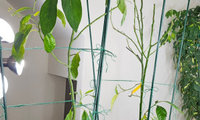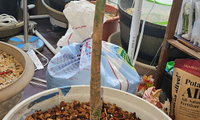Recent Activity

You can soak them in a 10% household bleach solution for 10 minutes or more, then rinse well and air dry in the sun to take care of any fungal spores that might be embedded in the fabric or adhering soil or organic matter.
Sterile soil is only sterile until the bag is open, and perhaps not even that long.
Al

Can i use the 5-1-1 mix but add some of the components of the gritty mix to make the soil last longer? Unquestionably, you can do whatever you like, but I can offer some input insofar as what to expect. Either medium will last at least as long as the point in time when the roots become so congested a full repot would be required to ensure your plant has the best opportunity to realize as much of its genetic potential as possible. If we assume you're able to maintain the plant at a high level of vitality, roots will likely congested to the point where they would benefit from a repot in spring at the beginning of the 3rd growth cycle, and definitely by spring of the 4th growth cycle (probably stretching it but not endangering the plant's viability).
As the 5:1:1 mix breaks down much more slowly than finer materials. By the time it has broken down to the point where you should be concerned about the soil's structure, the plant's roots are becoming a part of the soil's structure, so the real issue is the volume of soil (carbon) will be diminished by the soil gassing off (as CO2). The diminishing volume of soil will be unable to hold an adequate supply of resources, that, couple with the fact heavy (thick) roots with very few branching fine roots will have filled the pot at the expense of those fine roots that do all the plant's heavy lifting. The primary reason for repotting is to remove heavy roots to free up space for fine roots to grow.

Because the gritty mix is structurally more porous, it offers roots an extremely welcoming environment for growth, which typically shortens the interval between appropriate (timing of) repots.
Will the gritty components just separate out and not add any benefits? Are there reasons not to combine these two mixes such as pH or nutrient conflicts? The gritty mix will not likely stratify in the pot unless you aggressively flood the soil before the roots have colonized the entire soil column. It's primary benefit lies in the fact that it is a healthier environment for roots until root congestion fills the greater air space it offers; then, it becomes just another medium until you repot.
Al

What GardenGal said; plus, air movement is very helpful when it comes to keeping mite populations at acceptable levels, so a fan in the room and plenty of air movement would be a good thing.
A thorough spritz of 1 part of 70% rubbing alcohol (isopropyl alcohol - not scented) mixed with 1 - 2 parts two parts of water provides instant knockdown (death) of mites. The trick to its effectiveness is making sure you wet entirely all plant surfaces so there are no mites that do not come into contact with the mist. Misting at 4-day intervals for a couple of weeks should eliminate spider mite populations or reduce them to where they aren't a serious threat to your plants' well being. You can also use the mist prophylactically by spraying once weekly during the driest parts of winter when populations are most likely to increase rapidly.
Al

Consider a plant heat mat (those used to start seeds) wrapped around the pots. Warming the pot along with your LED lighting will encourage roots to grow and could jump start new buds to grow

@Atheen - 7a - in Maryland, USA Two things I've learned when it comes to nursery and greenhouse ops:
1) their focus is on the bottom line ($) and not on the long term effects their care practices have on the plant subsequent to the point in time when the plant is sold. The (previously) conventional process of potting plants up to a larger pot (nursery can) before the plant became rootbound to the point where the root/soil mass can be lifted from the pot intact have been mostly discarded because of the cost of added soil, cost of pot, and particularly because of the cost of labor to properly care for nursery crops. This results in the sealing of many plant's fates due to the effects of root congestion; and, the effects of the new 'labor saving' method results in the sale of a very high % of plants that shouldn't even be sold; this because once a plant has been allowed to become that rootbound, the negative effects are permanent, unless a pair of hands at some point gets into the root mass to correct congestion and problem roots.
2) Very few employees of nursery and greenhouse ops have anything resembling a even a reasonably good working knowledge of A) the impact of root congestion on plant health, growth rate, and the plant's ability to defend itself against insect herbivory and disease pathogens, and B) how to correct the root issues and perform a full repot. Currently, and due to labor costs, extremely few nursery ops pot up in a timely manner, and very precious few do anything about trying to correct a plant that has become extremely rootbound. It has become cheaper to destroy the plant than to correct its congested roots. This is why nursery/greenhouse employees look at you like you have a third eye when you start asking questions about high quality grow media and/or performing full repots. It has, unfortunately, become almost a foreign concept for anyone other than managerial staff, and even if the staff understands what the effects of root congestion are and how to eliminate the issue, no action is taken because of the added work's impact on the bottom line.
I wish I knew of a way to modify the 511 to make it a little heavier (so planters wouldn't fall with the slightest wind), but I wouldn't know where to begin on how to do that. This problem's resolution is actually quite easy. By a pot considerably larger than you think you'll need, and fill the bottom of the pot with bricks or large rocks. This 'ballast' not only provides added weight to help guard against toppling, it also reduces the volume of grow medium CAPABLE of holding excess (perched) water.
For any given soil that supports perched water, the max ht of the perched water column, for that soil, is a constant. IOW, no matter the size or shape of the pot, the max PWT ht will be the same. You can see (below) that 1) roots are reluctant to grow into areas of saturated soil, which leaves roots susceptible to fungi that cause root rot, and 2) when using gravel and other small objects as a "drainage layer", the layer simply raises the PWT to a position higher in the pot than it would be w/o the layer. Obviously, this is highly undesirable.

Using large objects like like bricks/rocks as ballast doesn't cause the same problem. The benefit of using ballast lies in the fact that it displaces grow medium that would normally be 100% saturated w/o raising the ht of the PWT.
If you have a bucket of water filled to the top, then drop a brick into the bucket, a volume of water equal to the displacement of the brick/ballast will overflow the rim of the bucked. On the other hand, if you have a 10x10 bucket with a drain hole filled with a grow medium that is supporting 4" of perched water soil (400 cu in), and you introduce a 2x4x8 brick at the bottom of that container, it will displace 64 cu" of soil saturated with PW. Since you can line the inside of a 10x10 pot with 4 bricks, leaving a hole in the middle of the arrangement, you can displace 256" of saturated soil with only 4 bricks. If you broke 2 additional bricks in half and added them to the bottom, you will have displaced 384 cu in of the 400 cu in capable of holding PW. The key to the bricks working as a ballast instead of a false bottom lies in the fact that there must be a continuous column of soil from the top of the soil line to the bottom of the pot to act as the wick through which the water is FORCED to flow out of the drain hole.
Wicks work well, but items judiciously considered and placed in the pot to serve as ballast work better; and, once the planting is established, the ballast works passively for as long as the planting exists. Use bricks/rocks if you need weight, or an overturned pot/bucket, or empty soda bottles (cap on) if you want to keep things light.

I hope your hand gets better. I'm starting to become somewhat burdened by arthritis in my hands and I notice that it can really slow one down.
Al






That's a screen shot of a chart Supreme Perlite no longer uses on their site, but you'll find more info under the "horticultural" heading.
Link: https://www.supremeperlite.com/service/horticultural-grade-perlite/
Al
Ha! I like that you can order 33 bags a for $1k. :o)
Tomorrow I will take a pic of my perlite with a ruler an we can see if ti measures up to others.